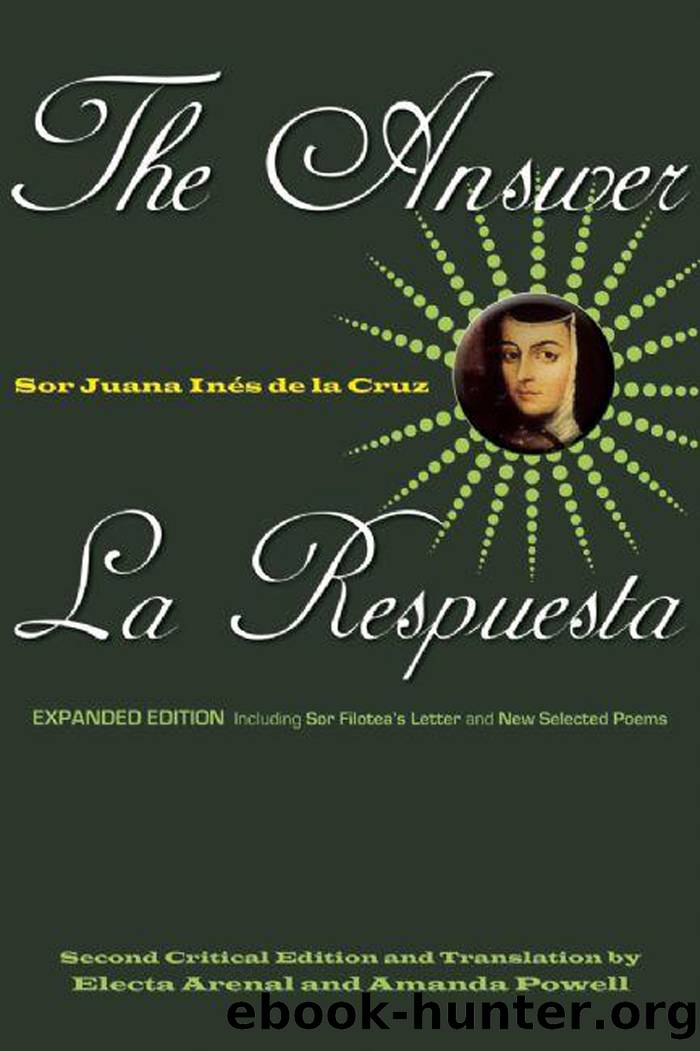The Answer La Respuesta (Expanded Edition) by Sor Juana Inés de la Cruz

Author:Sor Juana Inés de la Cruz
Language: eng
Format: epub
Publisher: The Feminist Press at CUNY
Published: 2020-02-15T00:00:00+00:00
Annotations to La Respuesta / The Answer
In preparing these notes, we sought to maintain the emphasis on gender that informs both Sor Juanaâs text and our edition of it. We have provided sufficient information to help students and general readers appreciate the sphere of intellectual concerns within which Sor Juana (SJ) wrote. Exhaustive treatment of her many classical, biblical, historical, and other references is beyond the scope of this work. See Abbreviations and âA Note on the Texts,â above.
Sor Filotea de la Cruz is the pseudonym of Manuel Fernández de Santa Cruz, the powerful and influential bishop of Puebla (1637â99). Literally, âPhilo-theaâ (from the Greek) means Lover-of-God; thus the whole name means Sister Lover-of-God of the Cross. Both the bishop preceding Fernández in Puebla and St. Francis de Sales, a French bishop and reformer whom Fernández greatly admired, had used the name to address nuns. Sor Juana was well aware she was answering to a male authority. On how and why the letter was written, see âThe Issues at Stakeâ in Pt. II of the Introduction, above.
(1) l. 8 the Angelic Doctor, St. Thomas Aquinas: 1225â74. âThe greatest figure of Scholasticism ⦠held that faith and reason constitute two harmonious realmsâ (CCE). According to the Golden Legend, Thomasâs teacher, Albertus Magnus, defended the âsilentâ Thomas from schoolfellows who derided him (DCLL). SJ thus implicitly draws a parallel between Thomas and herself, between Albertus and the bishop (who ought therefore to defend her), and between the ignorant schoolfellows and her detractors. Such parallels between herself and illustrious figures, both male and female, appear throughout the text.
ll. 12â13 in truth⦠worthy of you: See note on âfalse humility,â par. 3, below, and âSor Juanaâs Art and Argument,â in Pt. II of the Introduction, p. 30, above.
ll. 14â16 the favor ⦠of giving ⦠to the press / favor, de dar a las prensas: For commentary on wordplay contained here, see âThe Answer as Self-Defenseâ in Pt. II of Introduction, above.
l. 18 a rational being / ente de razón: From ens rationis, a Scholastic term, used here in the service of Baroque word-games. The bishop is placed in the realm often ascribed to women (the irrational), and Sor Juana in that of reason. The bishop has praised her unreasonably. Thus from the beginning, both playfully and seriously, SJ identifies herself with rational rather than supernatural religiosity.
1. 22 Quintilian: Marcus Fabius Quintilianus, c.E. c. 35âc. 95, the Roman rhetorician. SJ begins and ends this work by citing him, an indication of the profound influence on her of his Institutio oratoria [On the Education of an Orator], âa survey of education, literature, the principles of rhetoric and the life and training of the oratorâ (CCE). Quintilian was rediscovered in the Renaissance, and his name became synonymous with âteacher.â SJ clearly studied him and applied his rhetorical methods in structuring her arguments in the Answer (see Perelmuter Pérez).
11. 22â23 âThey produce less ⦠benefits conferredâ: SJ gives the Latin phrase as Minorem spei, maiorem benefacti gloriam pereunt.
Download
This site does not store any files on its server. We only index and link to content provided by other sites. Please contact the content providers to delete copyright contents if any and email us, we'll remove relevant links or contents immediately.
4 3 2 1: A Novel by Paul Auster(11788)
The handmaid's tale by Margaret Atwood(7446)
Giovanni's Room by James Baldwin(6808)
Asking the Right Questions: A Guide to Critical Thinking by M. Neil Browne & Stuart M. Keeley(5355)
Big Magic: Creative Living Beyond Fear by Elizabeth Gilbert(5350)
Ego Is the Enemy by Ryan Holiday(4954)
On Writing A Memoir of the Craft by Stephen King(4660)
The Body: A Guide for Occupants by Bill Bryson(4580)
Ken Follett - World without end by Ken Follett(4441)
Bluets by Maggie Nelson(4259)
Adulting by Kelly Williams Brown(4231)
Eat That Frog! by Brian Tracy(4147)
Guilty Pleasures by Laurell K Hamilton(4116)
White Noise - A Novel by Don DeLillo(3828)
The Poetry of Pablo Neruda by Pablo Neruda(3813)
Fingerprints of the Gods by Graham Hancock(3731)
Alive: The Story of the Andes Survivors by Piers Paul Read(3728)
The Book of Joy by Dalai Lama(3694)
The Bookshop by Penelope Fitzgerald(3616)
